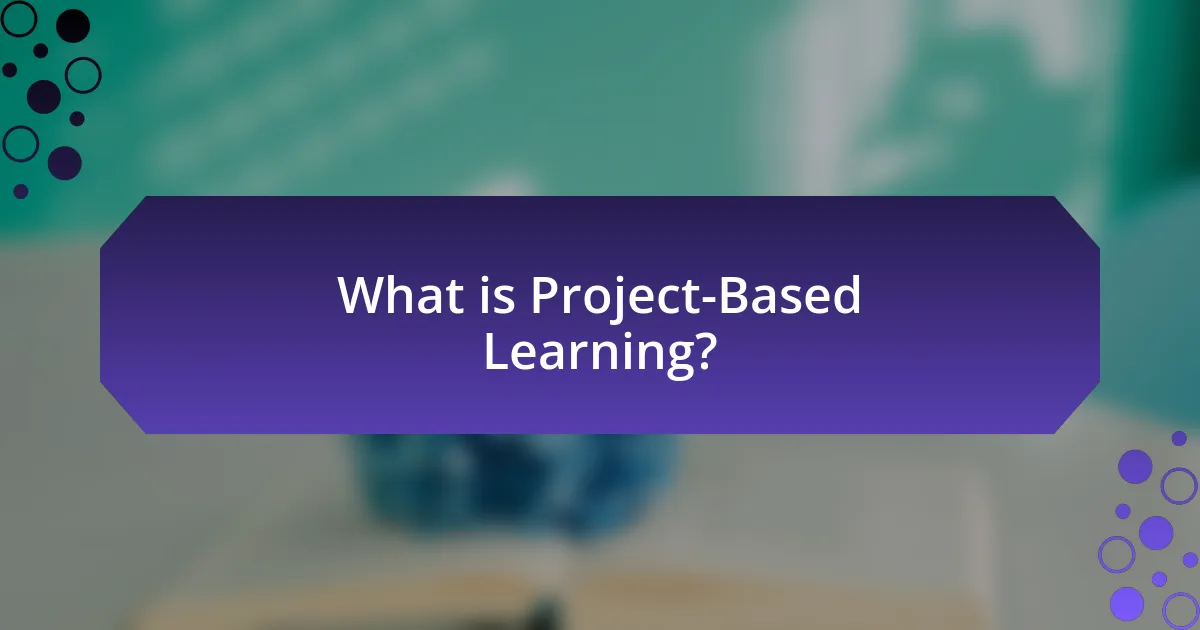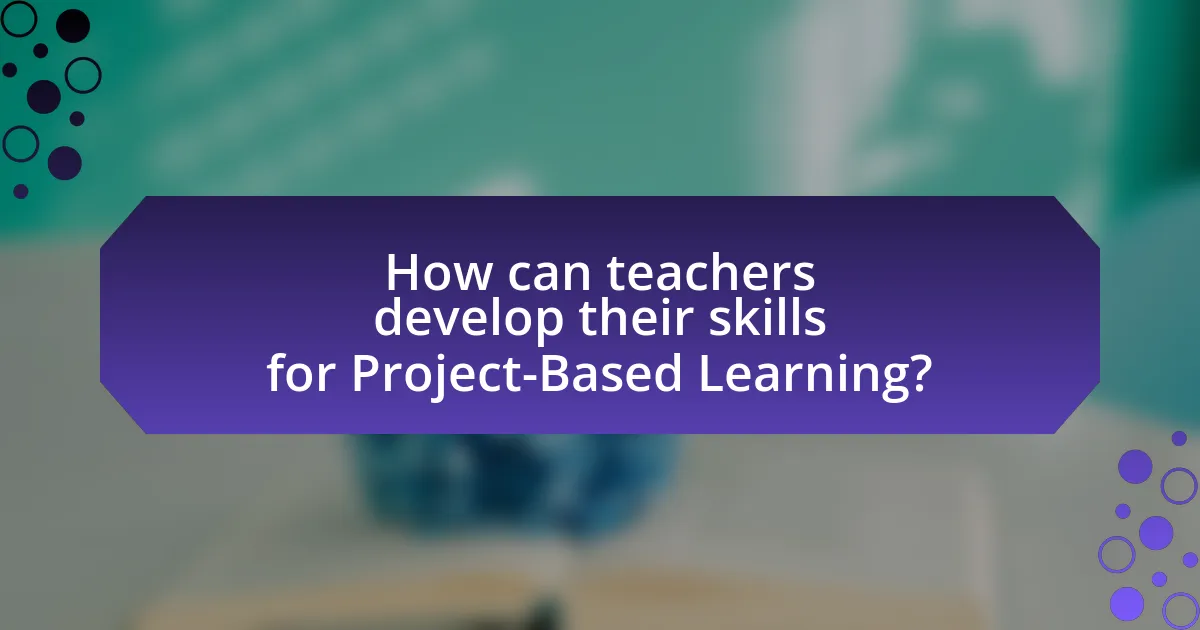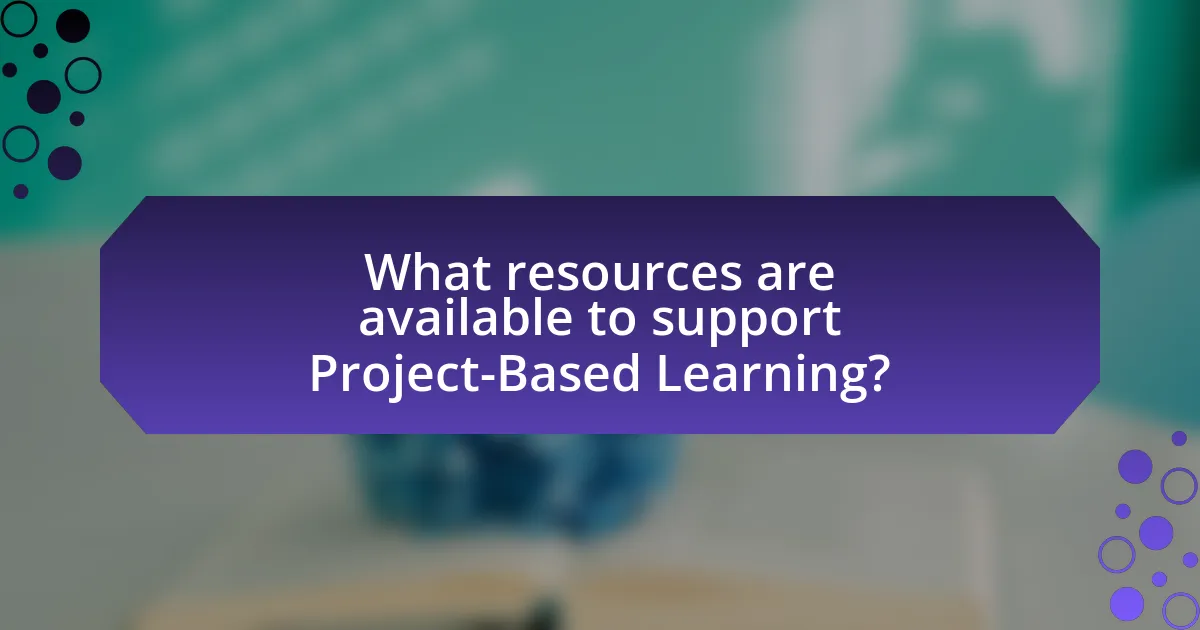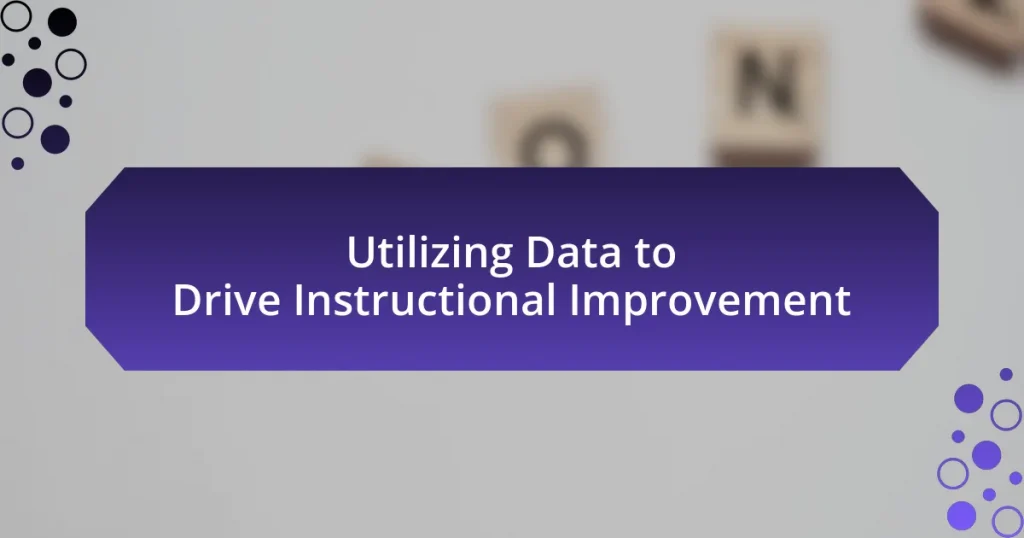The article focuses on implementing Project-Based Learning (PBL) and offers essential tips for teacher development. It defines PBL as an instructional methodology that promotes active exploration through real-world projects, enhancing critical thinking, collaboration, and communication skills among students. Key components of PBL, such as driving questions, student choice, and reflection, are discussed, along with strategies for effective planning, assessment, and classroom management. The article also addresses challenges teachers may face in adopting PBL and provides resources and best practices to support successful implementation, ultimately aiming to improve student engagement and learning outcomes.

What is Project-Based Learning?
Project-Based Learning (PBL) is an instructional methodology that encourages students to learn by engaging in real-world projects. This approach emphasizes active exploration, where students work on a project over an extended period, allowing them to investigate and respond to complex questions or challenges. Research indicates that PBL enhances critical thinking, collaboration, and communication skills, as students must work together to solve problems and present their findings. Studies, such as those conducted by the Buck Institute for Education, show that students in PBL environments often outperform their peers in traditional settings on assessments of understanding and retention.
How does Project-Based Learning differ from traditional teaching methods?
Project-Based Learning (PBL) differs from traditional teaching methods by emphasizing student-driven projects that foster critical thinking and real-world problem-solving. In PBL, students engage in hands-on, collaborative tasks that require them to apply knowledge in practical contexts, whereas traditional methods often rely on direct instruction and rote memorization. Research indicates that PBL enhances student engagement and retention of knowledge, as evidenced by a study published in the “Journal of Educational Psychology,” which found that students in PBL environments scored higher on assessments compared to those in traditional settings.
What are the key characteristics of Project-Based Learning?
Project-Based Learning (PBL) is characterized by its focus on student-centered inquiry, real-world relevance, and collaborative engagement. In PBL, students actively explore complex questions or problems over an extended period, which fosters critical thinking and problem-solving skills. Research indicates that PBL enhances student motivation and retention of knowledge, as it connects learning to real-life contexts. Additionally, PBL emphasizes collaboration among students, promoting teamwork and communication skills essential for success in the modern workforce. These characteristics collectively contribute to a deeper understanding of content and the development of essential life skills.
Why is Project-Based Learning effective for student engagement?
Project-Based Learning (PBL) is effective for student engagement because it actively involves students in real-world problem-solving and collaborative projects. This hands-on approach fosters deeper understanding and retention of knowledge, as students apply what they learn in meaningful contexts. Research indicates that PBL enhances motivation and engagement; for instance, a study published in the “Journal of Educational Psychology” found that students participating in PBL reported higher levels of interest and satisfaction compared to traditional learning methods. Additionally, PBL encourages critical thinking and creativity, essential skills for the 21st century, as students work together to explore complex issues and develop solutions.
What are the essential components of Project-Based Learning?
The essential components of Project-Based Learning (PBL) include a driving question, student voice and choice, a public product, and reflection. A driving question serves as the focal point that guides the project, encouraging inquiry and exploration. Student voice and choice empower learners to make decisions about their projects, fostering engagement and ownership. The creation of a public product allows students to showcase their work to an audience, enhancing the relevance of their learning. Finally, reflection enables students to evaluate their learning process and outcomes, promoting deeper understanding and continuous improvement. These components collectively enhance the effectiveness of PBL by fostering critical thinking, collaboration, and real-world application of knowledge.
How do real-world problems enhance Project-Based Learning?
Real-world problems enhance Project-Based Learning by providing students with relevant, authentic contexts that increase engagement and motivation. When students tackle real-world issues, they develop critical thinking and problem-solving skills, as they must analyze complex situations and devise practical solutions. Research indicates that students who engage in project-based learning centered around real-world problems demonstrate improved retention of knowledge and greater application of skills in various contexts, as evidenced by a study published in the Journal of Educational Psychology, which found that students involved in such projects scored higher on assessments compared to those in traditional learning environments.
What role does collaboration play in Project-Based Learning?
Collaboration is essential in Project-Based Learning as it enhances student engagement and fosters critical thinking. When students work together, they share diverse perspectives, which leads to more innovative solutions and deeper understanding of the subject matter. Research indicates that collaborative learning environments improve problem-solving skills and increase retention of knowledge, as students actively participate in discussions and peer evaluations. For instance, a study by Johnson and Johnson (2009) found that cooperative learning strategies significantly boost academic achievement and interpersonal skills among students. Thus, collaboration not only enriches the learning experience but also prepares students for real-world teamwork scenarios.
What challenges do teachers face when implementing Project-Based Learning?
Teachers face several challenges when implementing Project-Based Learning (PBL), including time constraints, lack of resources, and insufficient training. Time constraints often arise because PBL requires extensive planning and execution, which can conflict with standardized curriculum requirements. Additionally, teachers may struggle with limited access to materials and technology necessary for effective project implementation. Insufficient training can hinder teachers’ ability to facilitate PBL effectively, as they may lack the pedagogical skills needed to guide students through complex projects. Research indicates that these challenges can significantly impact the success of PBL initiatives in educational settings.
How can teachers overcome resistance to change in teaching methods?
Teachers can overcome resistance to change in teaching methods by actively involving stakeholders in the decision-making process. Engaging teachers, students, and parents in discussions about the benefits of new methods fosters a sense of ownership and reduces apprehension. Research indicates that when educators participate in the planning and implementation phases, they are more likely to embrace changes; for instance, a study by Fullan (2007) highlights that collaborative approaches significantly enhance buy-in and reduce resistance. Additionally, providing professional development opportunities tailored to the new methods equips teachers with the necessary skills and confidence, further facilitating acceptance of change.
What strategies can be used to manage classroom dynamics during projects?
Effective strategies to manage classroom dynamics during projects include establishing clear roles, setting expectations, and fostering open communication. By assigning specific roles to students, teachers can ensure that responsibilities are distributed evenly, which helps prevent conflicts and promotes collaboration. Setting clear expectations regarding behavior and project outcomes allows students to understand their objectives and the standards they must meet. Additionally, fostering open communication encourages students to express their ideas and concerns, which can lead to a more cohesive group dynamic. Research indicates that structured group work, where roles and expectations are clearly defined, enhances student engagement and reduces behavioral issues (Johnson & Johnson, 2009).

How can teachers develop their skills for Project-Based Learning?
Teachers can develop their skills for Project-Based Learning (PBL) by engaging in professional development programs specifically focused on PBL methodologies. These programs often include workshops, online courses, and collaborative planning sessions that emphasize hands-on experience and peer feedback. Research indicates that teachers who participate in structured PBL training report increased confidence and effectiveness in implementing PBL strategies in their classrooms. For instance, a study by the Buck Institute for Education found that teachers who underwent PBL training improved their instructional practices and student engagement levels significantly.
What professional development opportunities are available for teachers?
Professional development opportunities for teachers include workshops, online courses, mentorship programs, and conferences. Workshops often focus on specific teaching strategies, such as project-based learning, providing hands-on experience and practical tools. Online courses offer flexibility and a wide range of topics, allowing teachers to learn at their own pace. Mentorship programs pair less experienced teachers with seasoned educators for guidance and support. Conferences provide networking opportunities and exposure to the latest educational research and practices. According to the National Staff Development Council, effective professional development can lead to improved teaching practices and student outcomes.
How can workshops and training sessions enhance teacher skills?
Workshops and training sessions enhance teacher skills by providing targeted professional development opportunities that focus on effective teaching strategies and methodologies. These sessions often include hands-on activities, collaborative learning, and expert-led discussions, which allow teachers to practice new techniques in a supportive environment. Research indicates that teachers who participate in ongoing professional development, such as workshops, show improved instructional practices and student outcomes. For example, a study published in the “Journal of Teacher Education” found that teachers who engaged in structured professional development programs increased their pedagogical knowledge and classroom effectiveness, leading to higher student engagement and achievement.
What role do peer collaborations play in teacher development?
Peer collaborations play a crucial role in teacher development by fostering shared learning experiences and enhancing instructional practices. Collaborative environments allow teachers to exchange ideas, strategies, and feedback, which can lead to improved teaching effectiveness. Research indicates that teachers who engage in collaborative professional development report higher levels of confidence and competence in their teaching methods. For instance, a study by Vescio, Ross, and Adams (2008) found that collaborative professional development significantly impacts teachers’ instructional practices and student outcomes, demonstrating the effectiveness of peer interactions in professional growth.
How can teachers effectively plan and assess Project-Based Learning?
Teachers can effectively plan and assess Project-Based Learning (PBL) by establishing clear learning objectives, designing engaging projects that align with those objectives, and implementing formative and summative assessments throughout the project. Clear learning objectives guide the project’s direction and ensure that students understand the expected outcomes. Engaging projects should be relevant to students’ interests and real-world applications, which enhances motivation and learning. Formative assessments, such as peer reviews and self-assessments, provide ongoing feedback, while summative assessments, like presentations or final reports, evaluate the overall learning and project outcomes. Research indicates that structured PBL frameworks, such as those outlined by the Buck Institute for Education, enhance student engagement and learning outcomes, demonstrating the effectiveness of this approach in educational settings.
What are the best practices for designing a Project-Based Learning curriculum?
The best practices for designing a Project-Based Learning (PBL) curriculum include clearly defining learning objectives, integrating real-world problems, fostering collaboration, and incorporating reflection. Clearly defined learning objectives ensure that students understand the goals of the project and what they are expected to learn. Integrating real-world problems engages students by making the learning relevant and applicable to their lives, which has been shown to increase motivation and retention of knowledge. Fostering collaboration among students promotes teamwork and communication skills, essential for success in both academic and professional settings. Incorporating reflection allows students to evaluate their learning process and outcomes, which enhances critical thinking and self-assessment skills. Research indicates that these practices lead to improved student engagement and achievement in PBL environments, as evidenced by studies conducted by the Buck Institute for Education, which highlight the effectiveness of PBL in enhancing student learning outcomes.
How can assessment be integrated into Project-Based Learning?
Assessment can be integrated into Project-Based Learning (PBL) by employing formative and summative assessments throughout the project cycle. Formative assessments, such as peer reviews and self-assessments, allow students to reflect on their learning and receive ongoing feedback, which is crucial for their development. Summative assessments, including final presentations and project reports, evaluate the overall learning outcomes and mastery of content. Research by Thomas Markham in “Project Based Learning Handbook” emphasizes that integrating assessment into PBL not only enhances student engagement but also aligns with educational standards, ensuring that learning objectives are met effectively.

What resources are available to support Project-Based Learning?
Resources available to support Project-Based Learning include online platforms, curriculum guides, and professional development workshops. Online platforms such as Edutopia and the Buck Institute for Education provide extensive resources, including project ideas and assessment tools. Curriculum guides from organizations like the National Education Association offer structured frameworks for implementing project-based learning effectively. Additionally, professional development workshops, often conducted by educational institutions or teaching organizations, equip educators with the necessary skills and strategies to facilitate project-based learning in their classrooms. These resources collectively enhance the implementation and effectiveness of project-based learning initiatives.
What types of materials can enhance Project-Based Learning experiences?
Various materials can enhance Project-Based Learning experiences, including digital tools, hands-on resources, and collaborative platforms. Digital tools such as Google Workspace and project management software facilitate organization and communication among students. Hands-on resources like building kits, art supplies, and scientific equipment allow students to engage in experiential learning. Collaborative platforms, including discussion forums and shared documents, promote teamwork and idea exchange. Research indicates that integrating diverse materials in Project-Based Learning can lead to improved student engagement and deeper understanding of concepts, as evidenced by studies showing increased motivation and retention rates among students using varied resources.
How can technology be utilized in Project-Based Learning?
Technology can be utilized in Project-Based Learning by facilitating collaboration, enhancing research capabilities, and providing tools for presentation and feedback. For instance, platforms like Google Workspace enable students to work together in real-time, regardless of location, which fosters teamwork and communication skills. Additionally, online databases and digital libraries give students access to a wealth of information, allowing them to conduct thorough research for their projects. Tools such as presentation software and video editing applications help students effectively showcase their findings, while online feedback systems enable peer and instructor evaluations, promoting continuous improvement. These applications demonstrate how technology enhances the learning experience by making it more interactive and accessible.
What community resources can support Project-Based Learning initiatives?
Community resources that can support Project-Based Learning initiatives include local businesses, non-profit organizations, educational institutions, and community centers. These resources provide expertise, materials, and real-world contexts that enhance learning experiences. For instance, local businesses can offer mentorship and resources for projects, while non-profits may provide funding or volunteer support. Educational institutions can facilitate partnerships for shared learning opportunities, and community centers often host workshops or events that align with project themes. Research indicates that collaboration with community resources significantly improves student engagement and learning outcomes in Project-Based Learning environments.
What are the best practices for successful Project-Based Learning implementation?
The best practices for successful Project-Based Learning (PBL) implementation include clearly defining learning objectives, fostering collaboration among students, and integrating real-world problems into projects. Clearly defined learning objectives ensure that both educators and students understand the goals of the project, which enhances focus and direction. Collaboration among students promotes teamwork and communication skills, essential for effective project outcomes. Integrating real-world problems makes learning relevant and engaging, as evidenced by studies showing that students retain information better when it is connected to real-life contexts. Additionally, providing ongoing feedback and reflection opportunities helps students assess their progress and deepen their understanding, further supporting successful PBL implementation.
How can teachers create a supportive environment for Project-Based Learning?
Teachers can create a supportive environment for Project-Based Learning by fostering collaboration, providing resources, and encouraging student autonomy. Collaboration among students enhances communication skills and teamwork, which are essential for successful project outcomes. Providing access to diverse resources, such as technology and materials, equips students with the tools necessary to explore their projects effectively. Encouraging student autonomy allows learners to take ownership of their work, promoting engagement and motivation. Research indicates that environments that support collaboration and autonomy lead to higher student achievement and satisfaction in project-based settings.
What tips can help teachers facilitate effective student collaboration?
To facilitate effective student collaboration, teachers should establish clear goals and roles for each group member. This clarity helps students understand their responsibilities and fosters accountability. Additionally, incorporating structured activities, such as think-pair-share or jigsaw, encourages interaction and ensures that all voices are heard. Research indicates that when students engage in collaborative learning, they develop critical thinking and communication skills, which are essential for their academic and social development. Furthermore, providing regular feedback and opportunities for reflection allows students to assess their collaboration skills and make necessary adjustments, enhancing the overall learning experience.



